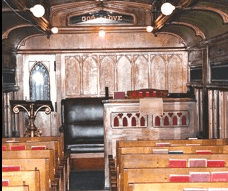Railcars were converted into small chapels, complete with short pews and often a piano or a foot pump organ. One end of the chapel car would have cramped living quarters for the pastor, and his spouse if he were married. In the United States, Chapel Cars were built and dedicated into service by the Episcopal Church, the American Baptist Churches and also the Roman Catholic Church. The American Baptist dedicated the largest number of Chapel Cars.
The idea for the chapel car was to have the railcar parked in a rail siding of a community and begin a new church plant. As the church body would grow the congregation would be encouraged to move to a building in the community. The Chapel Car would then be free to relocate and begin in a new community and begin a new congregation. (American Baptists missionaries have a long history of working themselves out of a job and giving the ministry to those who live locally.)
The first American Baptist Chapel Car, called Evangel, was dedicated in May of 1891. Between 1891 and 1915, the American Baptist built, and dedicated, seven Chapel Cars. The final Chapel Car to be dedicated, named Grace, is on permanent display at the American Baptist Assembly at Green Lake, Wisconsin.
The first photo below is one of my favorite Chapel Car photos, it is of the Chapel Car Good Will. Chapel Car Good Will is in the process of being restored by The National Museum of American Religion. This link will direct you to a page on the American Baptist Historical Society website that mentions the restoration project. https://abhsarchives.org/chapel-car-good-will-restored/
The second photo below shows a portion of the inside of Chapel Car Grace. On the left of the photo, behind the lectern, is the door leading to the very small living quarters.






